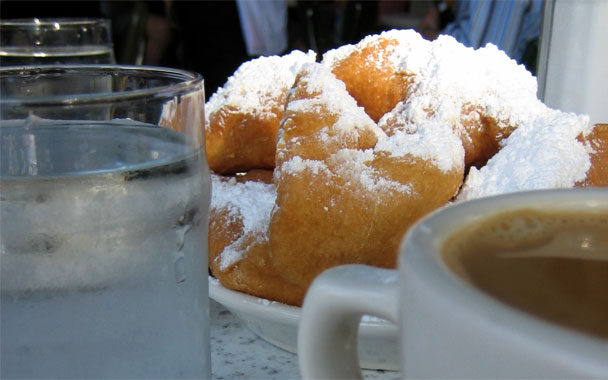I was a fat little boy, growing up in my mother’s pantry, digging for snacks around a bright orange tin of Café du Monde coffee. We never drank it, a gift from friends that my mother kept as a mark of sophistication—a can of famous coffee with a French name.
I was drawn to that tin. Part of it was how it looked: a dated font and an illustration of the cafe, open air in this strange place called New Orleans, evoking a faraway romance. The other part of it was its promise of beignets, described as the French doughnuts they serve alongside their coffee. I didn’t know what French doughnuts were or what made them French, but for years I knew I wanted them badly. Remember, I was a fat little boy.
I finally got to New Orleans decades later, memories of that pantry distant. I took an evening walk in the French Quarter despite its reputation as a Purgatory of drunken tourists, and marveled at its ornate beauty. I was in love right away with its buildings, their human scale, their prominent balconies just overhead, suggesting a place where private homes mingle intimately with public space. I wandered its tight streets, dark and solemn in the months after Hurricane Katrina, and came across a scene: hundreds of murmuring voices under slow ceiling fans, people drinking milky coffee and eating puffy fried dough buried under powdered sugar. I was, I realized, at the Café du Monde.
I sat and right away felt a strong attachment to the place. Literally: I was stuck to the table, bonded by an invisible glue of sugar and humidity. So it was the sugar I noticed first—a slurry of it on my arm, bursts of it exhaling into the air, piles of it falling to people’s laps, to the floor...so much powdered sugar, wild, uncontrollable quantities of powdered sugar.
I flagged down a server clad in a uniform that involved a paper hat. He grunted a response to my order and dashed off, exposing cloud prints of powdered sugar on his pant legs. Seconds later he was back dropping off a plate of beignets, sloshing coffee over the lip of my cup, and asking for cash while surveying restlessly for his next customer. I was charmed by his charmlessness.
My first bites of warm beignet proved I was right to want them even before I knew what they were. They were airy and chewy, substantial but made dainty by that sugar. Sips of the brew, whose chicory bitterness was softened with milk, caused the fried flavor to expand and bloom: the magic that coffee does with rich, sweet things. As a small unifying gesture, I sprinkled the excess sugar into the rest of my coffee. Tiny drops of oil floated gorgeously in the cup as I enjoyed the warm, dark night. I wrote a note to my mother, listened to the street performers taking advantage of the captive audience, and watched as the evening grew later and the clientele slowly turned over.
Next week: But isn’t it just a tourist trap?




 Pinterest
Pinterest


